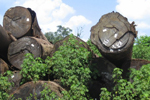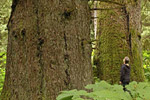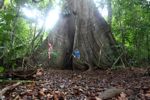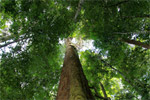The decline of large trees is putting biodiversity and forest health at risk globally, warn researchers writing in the journal Science.
In a commentary published Friday, December 7, David Lindenmayer, William Laurance, and Jerry Franklin argue that large trees typically found in old-growth forests play a critical ecological role, offering niche habitats for wildlife, storing large amounts of carbon, and providing abundant fruit, foliage, and flowers. But they note that a spate of studies suggest that big old trees are in decline in many ecosystems around the world: California has lost 95 percent of its redwoods, Swedish forests have experienced more than a 90 percent decline in large tree density, and fragmented Brazilian rainforests typically see a 50 percent die-off of big trees within 30 years of isolation.
 Big Dipterocarp in the rainforest of Sumatra, Indonesia. Photo by Rhett A. Butler |
Big trees are particularly targeted by loggers, but they are also exceptionally vulnerable to ecosystem change, including drought, increased incidence of wildfires, edge effects, and disease. These conditions can lead to elevated rates of mortality and reduced recruitment, with trickle-down effects for wildlife and plant communities, according to the authors.
Lindenmayer and colleagues say that the consequences of big tree decline are still poorly understood, necessitating more research.
“Just as large-bodied animals such as elephants, tigers, and cetaceans have declined drastically in many parts of the world, a growing body of evidence suggests that large old trees could be equally imperiled,” they write. “Targeted research is needed to better understand their key threats and devise strategies to counter them. Without such initiatives, these iconic organisms and the many species dependent on them could be lost or greatly diminished.”
CITATION: David B. Lindenmayer, William F. Laurance, Jerry F. Franklin. Global Decline in Large Old Trees. Science 7 December 2012: Vol. 338 no. 6112 pp. 1305-1306 DOI: 10.1126/science.1231070
Related articles
Experts: sustainable logging in rainforests impossible

(07/19/2012) Industrial logging in primary tropical forests that is both sustainable and profitable is impossible, argues a new study in Bioscience, which finds that the ecology of tropical hardwoods makes logging with truly sustainable practices not only impractical, but completely unprofitable. Given this, the researchers recommend industrial logging subsidies be dropped from the UN’s Reducing Emissions from Deforestation and Forest Degradation (REDD+) program. The study, which adds to the growing debate about the role of logging in tropical forests, counters recent research making the case that well-managed logging in old-growth rainforests could provide a “middle way” between conservation and outright conversion of forests to monocultures or pasture.
Industrial logging leaves a poor legacy in Borneo’s rainforests

(07/17/2012) For most people “Borneo” conjures up an image of a wild and distant land of rainforests, exotic beasts, and nomadic tribes. But that place increasingly exists only in one’s imagination, for the forests of world’s third largest island have been rapidly and relentlessly logged, burned, and bulldozed in recent decades, leaving only a sliver of its once magnificent forests intact. Flying over Sabah, a Malaysian state that covers about 10 percent of Borneo, the damage is clear. Oil palm plantations have metastasized across the landscape. Where forest remains, it is usually degraded. Rivers flow brown with mud.
Greenpeace calls for global REDD standards to reduce negative impacts of forest carbon projects
(06/26/2012) Greenpeace has launched a consultation process to establish global standards for Reducing Emissions from Deforestation and Degradation (REDD+) projects.
U.S. legislation threatens oldest, tallest trees in Tongass rainforest

(02/27/2012) Up to 17 percent of the tallest old-growth trees in the Tongass temperate rainforest could be cut under new U.S. legislation, according to a report by Audubon Alaska. The report argues that the legislation under consideration (S 730 and HR 1408) would resurrect the banned practice of “high-grading,” which allows loggers to select the largest, most-ancient trees across the forest for cutting despite their ecological importance. The legislation is a part of a controversial 65,000 acre logging concession in Tongass to Sealaska Corporation, which is owned by 20,000 members of Native communities, from the Tlingit, Haida and Tsimshian tribes.
Big trees, like the old-growth forests they inhabit, are declining globally

(01/26/2012) Already on the decline worldwide, big trees face a dire future due to habitat fragmentation, selective harvesting by loggers, exotic invaders, and the effects of climate change, warns an article published this week in New Scientist magazine. Reviewing research from forests around the world, William F. Laurance, an ecologist at James Cook University in Cairns, Australia, provides evidence of decline among the world’s ‘biggest and most magnificent’ trees and details the range of threats they face. He says their demise will have substantial impacts on biodiversity and forest ecology, while worsening climate change.
Logging of primary rainforests not ecologically sustainable, argue scientists

(01/25/2012) Tropical countries may face a risk of ‘peak timber’ as continued logging of rainforests exceeds the capacity of forests to regenerate timber stocks and substantially increases the risk of outright clearing for agricultural and industrial plantations, argues a trio of scientists writing in the journal Biological Conservation. The implications for climate, biodiversity, and local economies are substantial.